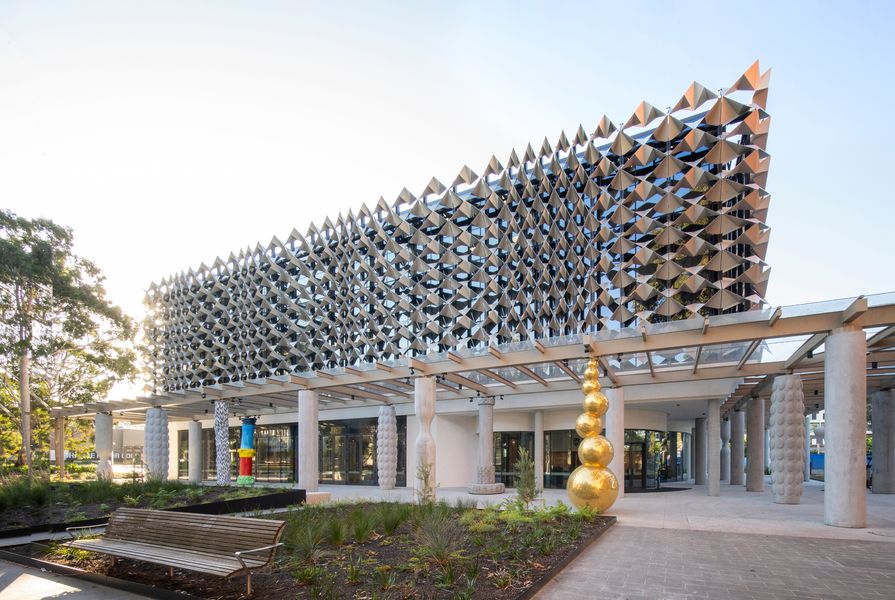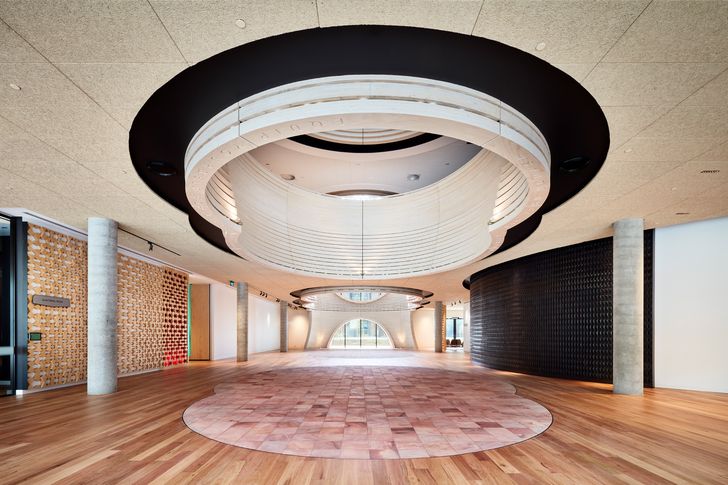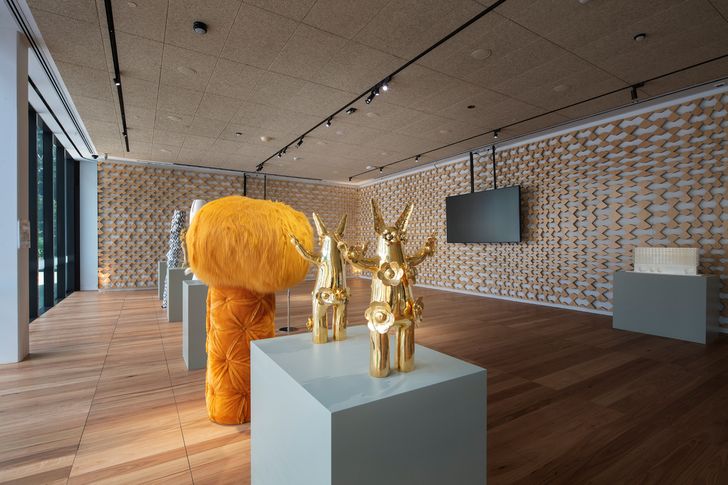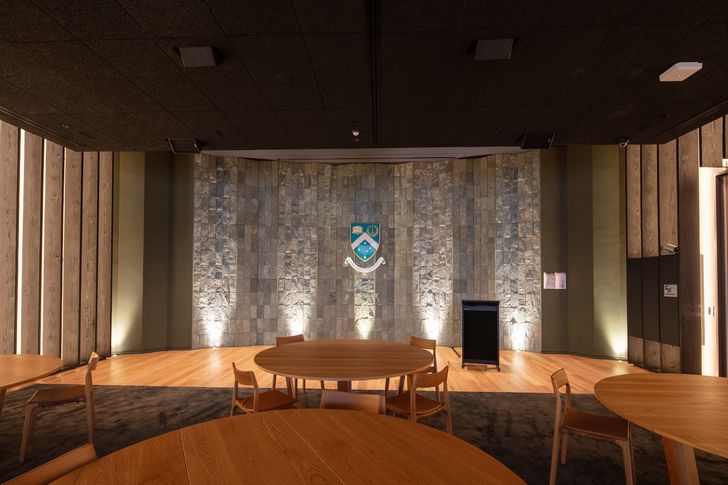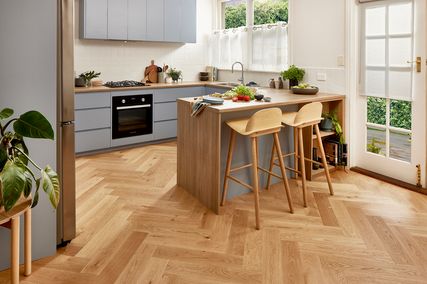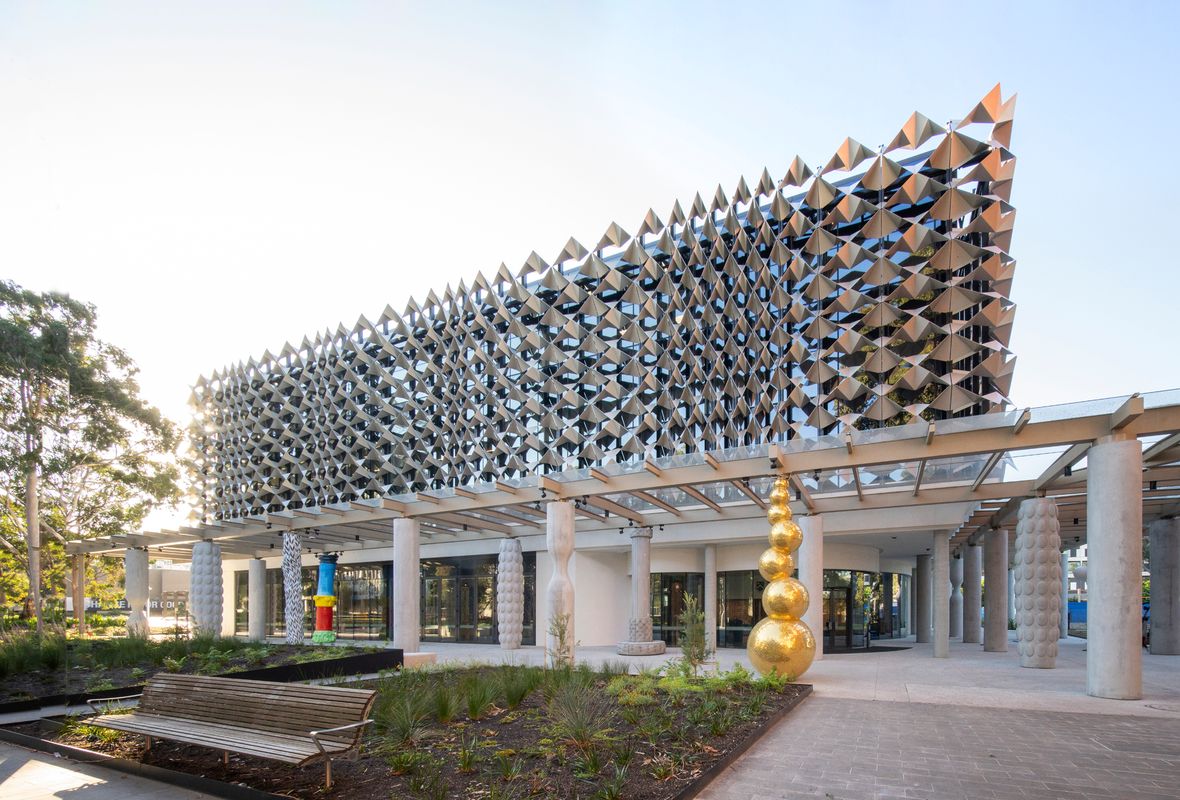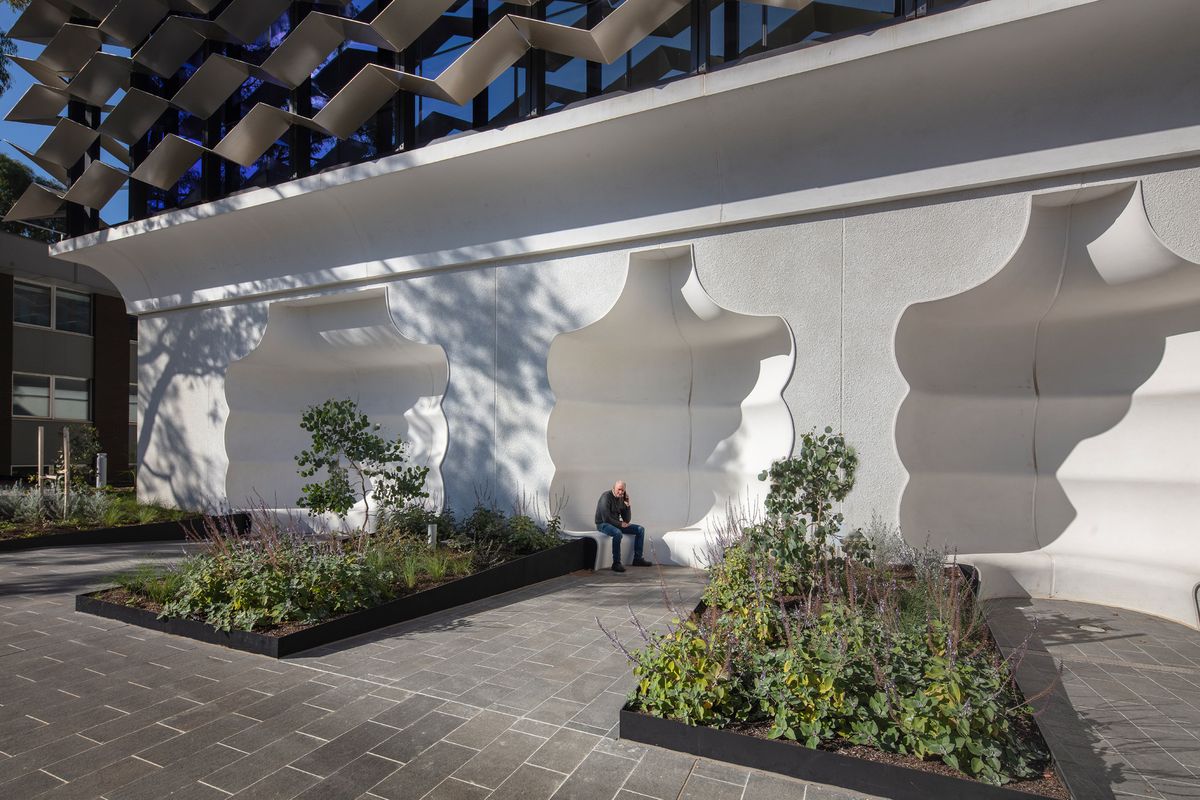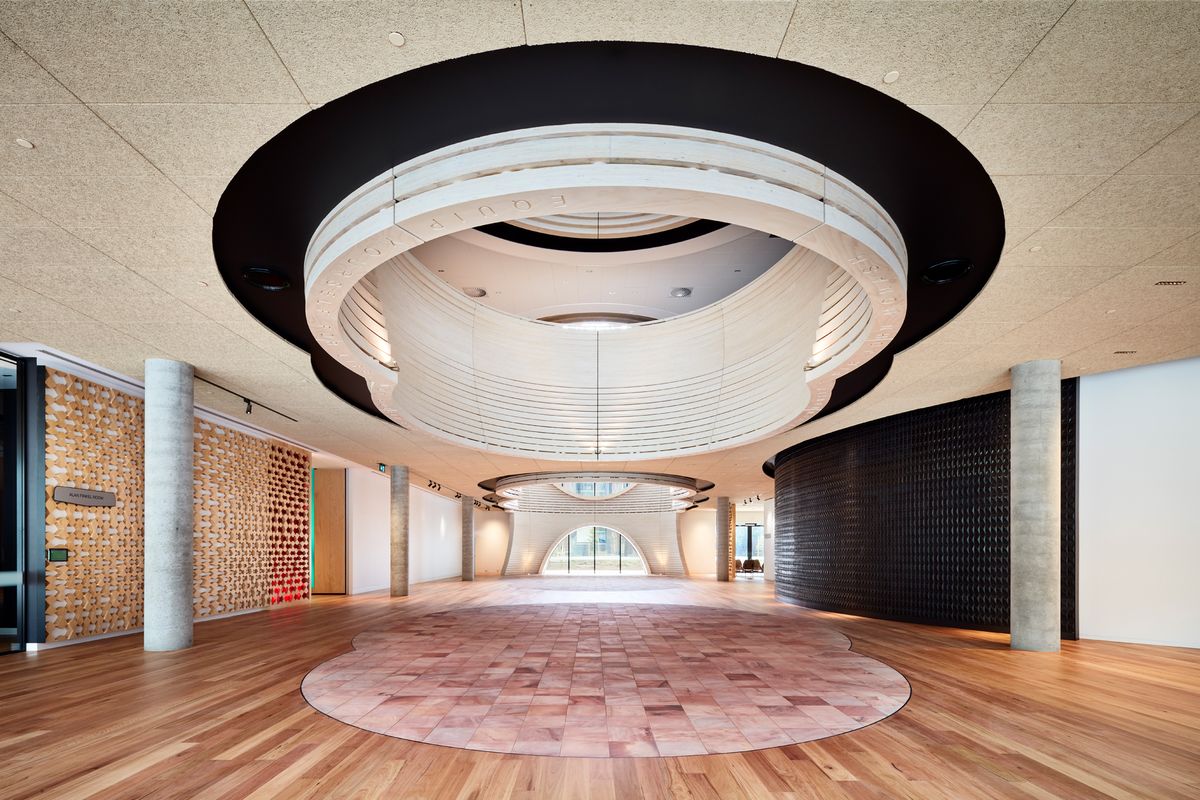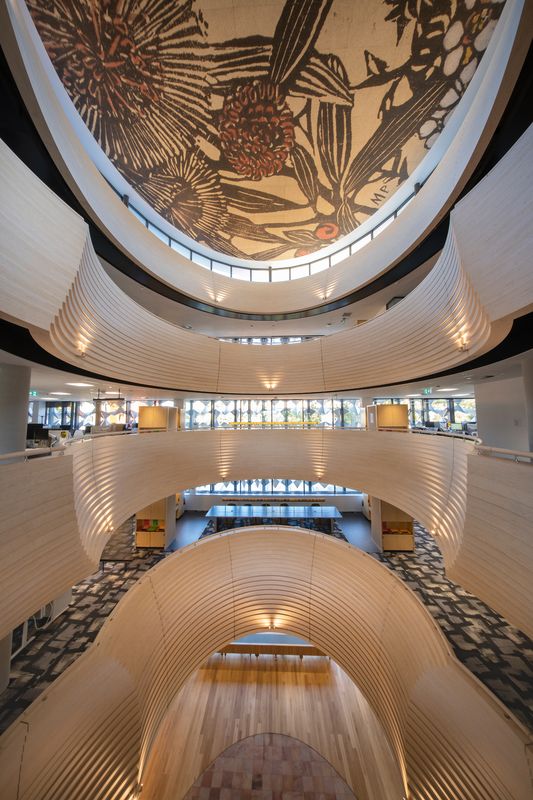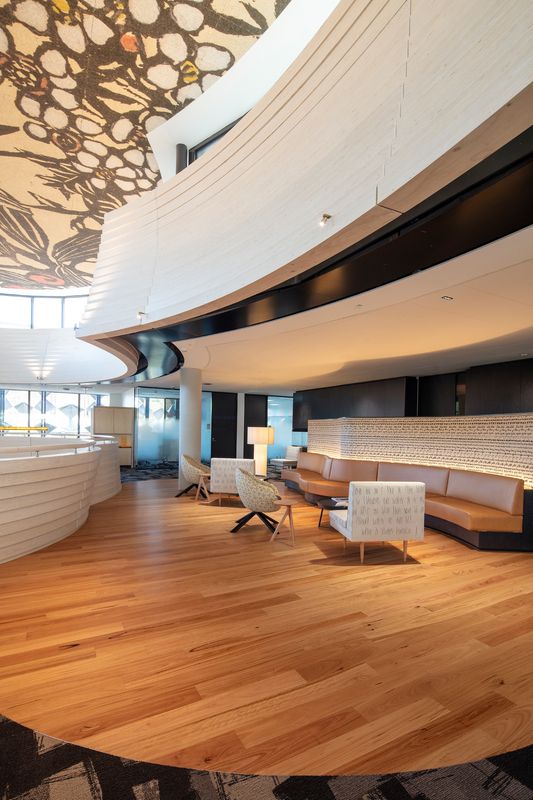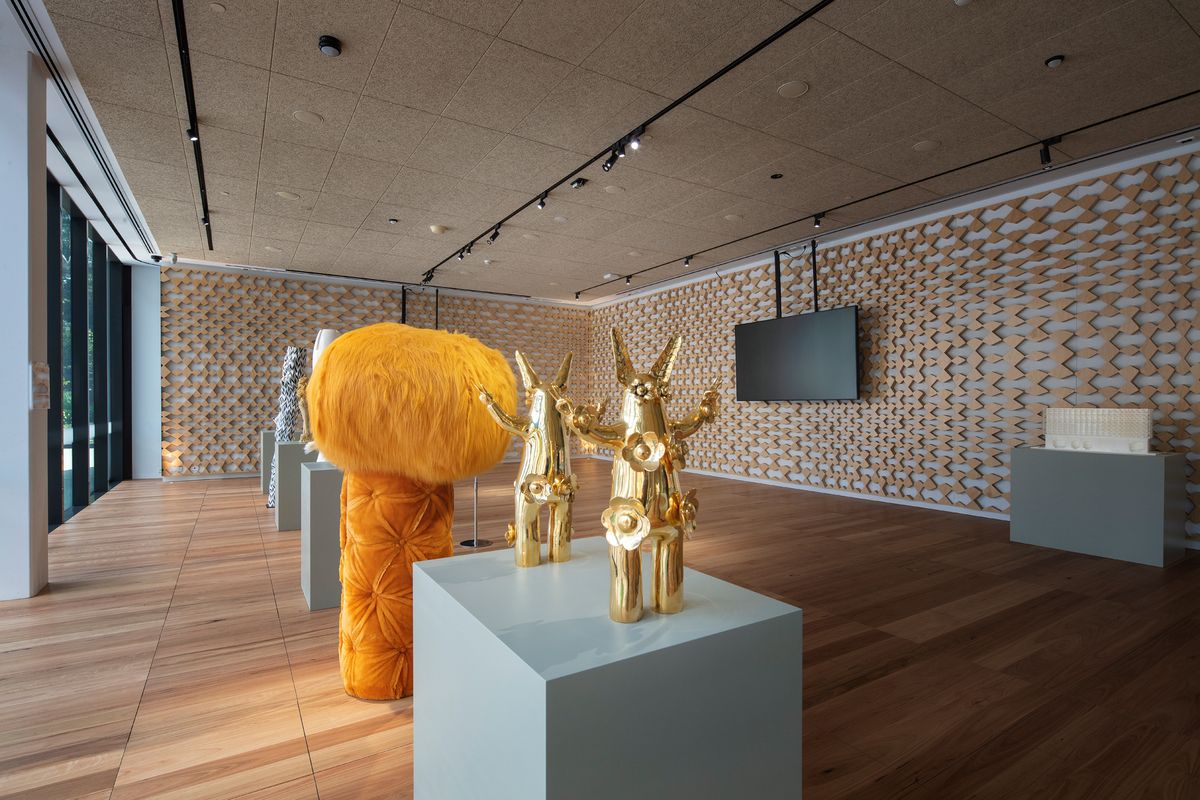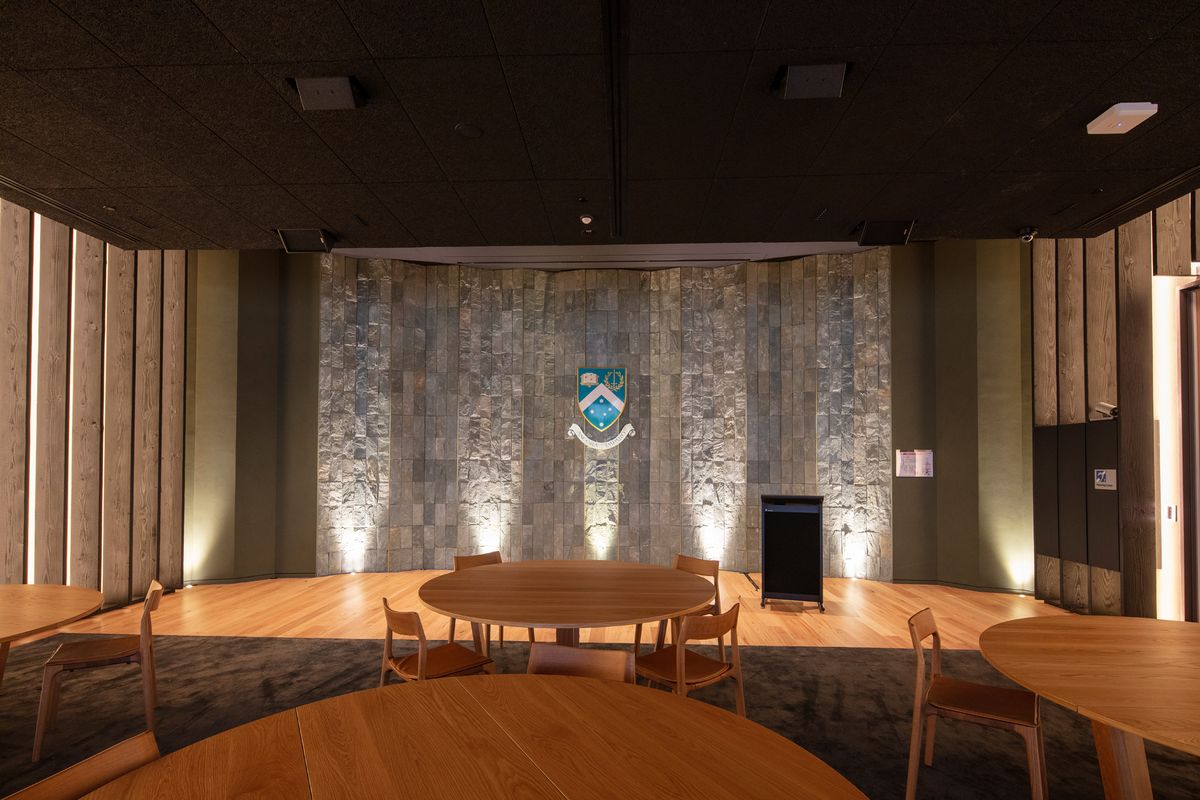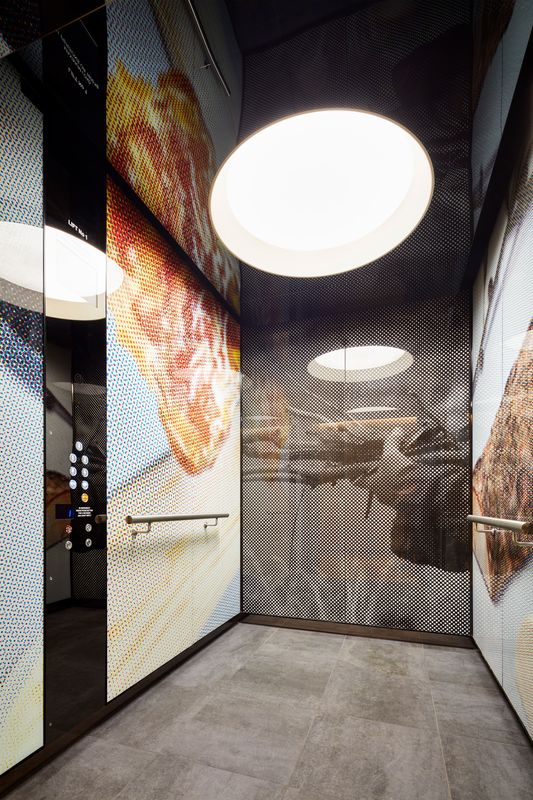ARM Architecture’s design for the new Chancellery at Monash University’s Clayton campus in Victoria is a delightful building dripping with history. Ian McDougall, one of ARM Architecture’s founding directors, explains that the intent was “to make it feel like it was a building that was already there, but with a new refurbishment.” The four-storey building is a vast improvement on its 1960s Brutalist-style predecessor, by Godfrey, Spowers, Hughes, Mewton and Lobb (1965). Designed in the tradition of a mid-century corporate headquarters, its form and character take cues from the original Clayton campus setting and are an affectionate ode to the former Chancellery. It recasts, reuses and reimagines fragments from the original building and, by doing so, etches its radical past into the new fabric. While the ground level provides a more permeable and connected edge than its predecessor, its interior light-filled spaces showcase Australian craft and design. The new Chancellery houses basement car parking, ground-level public spaces, places to welcome distinguished visitors and industry partners, and three levels of offices for the senior executive team and its support staff.
Located 20 kilometres south-east of central Melbourne, Monash University Clayton is a mid-century campus with a masterplan designed by Bates Smart McCutcheon (1960). The original aspirations of the university were to offer a counterpoint to sandstone universities and to propel applied research through fields like engineering and the sciences. The campus was in need of an upgrade, and ARM’s Chancellery building joins a group of new buildings on the site that offer a more contemporary approach to campus design. Key on the agenda with Monash University’s current thinking around campus architecture is its net-zero carbon emissions strategy, which ARM respects in the Chancellery by designing to Passivhaus principles.
Abstract-shaped grottoes are carved out of the western facade, providing a pleasant place to sit and connecting the building to its surrounds.
Image: John Gollings
In true ARM style, the design approach was one of “messy vitality,” to quote from Robert Venturi. This is most clearly expressed in the way the rectangular building is wrapped with a decorative steel screen – a simple shading device, you might say, that conforms to Passivhaus principles by controlling heat gain. But this screen is also oozing with layers of history that bring a richness and meaning to the design.
Firstly, the screen is a kind of reincarnation of the screen from the former Chancellery building – a screen that was eventually removed, “probably because it was considered too vulgar,” suggests architectural historian Conrad Hamann. Secondly, it cleverly advances the “brise-soleil” sun-breakers of mid-century design through the use of digital fabrication. Rather than the simple repetitive elements typical of mid-century brise-soleils, the geometric pattern of this screen changes and fluctuates across the surface, resulting in a moiré effect that is a bit like a 1960s Bridget Riley painting. Thirdly, the craft of the screen reinforces the roots of the university as a demonstration of “applied research” and the skill of contemporary Australian manufacturing design – in this case, Fabmetal Specialists. Fourthly, it draws on a lineage of mid-century corporate headquarters and is a direct reference to Edward Durell Stone’s Embassy of the United States of America in New Delhi (c. 1959), though it also reminds me of the wonderful brise-soleils designed by local émigré architects Holgar and Holgar.
Serendipitously, the etymology of the word “chancellery,” which stems from the Latin cancellus, reflects both the screen and the function of the building. While the cancellarius were like the adjudicators of Rome, so too the occupants of the Chancellery building are the key decision-makers of the university. And, to extend the connection further, the word cancelli describes the screen that separated the judge and counsel from the audience in a Roman court of law.
Shadows” of pink Kimberley sandstone are reflected on the floor beneath the voids.
Image: Rhiannon Slatter
When ARM principal and design architect for the project Jeremy Stewart took me around the new facilities, I was struck by the public nature of the building – a “quiet icon,” as Stewart describes it. Chancellery buildings are typically fortress-like, but this building actively connects to its surrounds and reinvigorates the spine of the site in a more contemporary approach to campus design. While the former building was separated from the public via a moat, the new Chancellery offers a generous cloister with a colonnaded edge around two of its faces. This L-shaped cloister provides a welcoming space for students and visitors, augmented by the outdoor seating and landscape designed by Openwork that echoes the mid-century flavour. The colonnade also performs as a procession space; after “gowning up” in the Chancellery building, the senior management team and academics ceremoniously parade through to Robert Blackwood Hall (Roy Grounds, 1971), where the graduations take place. Grottoes are carved out of the two remaining facades, which face the Religious Centre (Mockridge, Stahle and Mitchell, 1968) and Guilford Bell’s addition to the former Union building (1970), inviting people to get up close to the building. These urban connections are a vast improvement on the original Chancellery.
With its seven unique artist-designed columns, the Chancellery’s colonnade exudes greater civic delight than a Joze Plecnik colonnade. The result of a collaboration with the Monash University Museum of Art (MUMA), the art columns were designed by local and international artists from diverse cultural backgrounds to reflect the values of Monash University, and there is provision to add more in the future. These art columns – each one with its own distinct character – are tactile and colourful. Yolngu artist Gunybi Ganambarr, for example, has designed a bumpy and textured black and white column inspired by sacred larrakitj (memorial poles), while Melbourne-based Thai artist Vipoo Srivilasa’s golden-tiled column of spheres references Thai Buddhist temples.
It terms of the building’s massing, Passivhaus principles drove the rectangular form. Hence, any expressive gestural moments you might expect from an ARM Architecture design occur internally. As the practice explains it: “Imagine the building as a solid block, and we carved out two bunches of giant chair legs in random shapes from the block’s centre. This created two great rounded voids whose shapes we simplified somewhat. Next, we carved out the rest of the interiors, leaving only the floor plates and ceiling.”
The Alan Finkel Room is a creative space that opens up to the colonnade and adjoining atrium. Artworks: Pet Tomb by Kathy Temin; Opulent Blossom and Eve by Vipoo Srivilasa.
Image: John Gollings
As you walk into the ground-level atrium space, these voluptuous voids create a sense of drama in what is essentially an office building with a light well. One void is entirely internal while the other has a vast north-facing ground-to-roof window. The architect describes “shadows” of these voids registering as pink Kimberley sandstone insets on the ground floor. As you look up through the voids, you see an exquisite image of Australian native flowers printed onto a “spaghetti” ceiling (made from recycled wood-textured panelling) and naturally illuminated by clerestory windows on the upper level, “like a fresco.” This image, sourced from the National Gallery of Australia collection, is a 30-metre-by-11-metre scaled-up reproduction of the great Australian artist Margaret Preston’s woodcut print, Tea-Tree and Hakea Petiolaris (1936). McDougall explains this masterful move, led by ARM principal Andrea Wilson, as follows: “We were looking for something that was readable and powerful when it was enlarged and which also represented the possibilities of Australian design and its history.”
There are moments of joy throughout the interior spaces – like the beautifully crafted table comprised of an assemblage of “random” chair legs bunched up together and echoing the chair-leg design theme, or the reimagining of the brise-soleil as a mid-century-style room-dividing screen. There is also a homeliness to the upper-level office spaces that steers away from a corporate aesthetic.
An integration of fragments from the original building further imprints its history. These fragments include the original Featherston-designed furniture, and the green schist stone and crest (which now occupy the Academic Boardroom), along with the tiles salvaged from the main chancellery room, which line a wall in the atrium and include some replica additions that differ slightly in tone.
A green schist stone and crest from the original chancellery adorn the Academic Boardroom.
Image: John Gollings
But it is the recasting of the stairwell from the former Chancellery building that seals in the university’s history. Monash University is renowned for its radical left student activities during the 1960s and early 1970s – like its Maoist-dominated Labor Club, its epic student meetings on the lawns and its well-known student newspaper, Lot’s Wife. At one stage, the stairwell of the former Chancellery building was occupied by students protesting for rights to the building – an event that is now etched in as a permanent memory through the reinstating of this stairwell. I like to think that this is why the new facilities have been designed to be both very private and very public – students and visitors can see in from outside, peer up to the senior management via the voids, and even enter the ground-level Alan Finkel Room or inhabit the atrium during events, yet the building remains highly secure and restricted.
— Christine Phillips is a registered architect, senior lecturer at RMIT University and director of OoPLA. She is passionate about Australian architecture and cultural heritage.
Credits
- Project
- Monash University Chancellery
- Architect
- ARM Architecture
Australia
- Project Team
- Ian McDougall, Andrew Smith, Justin Fagnani, Jeremy Stewart, Andrea Wilson, Fiona Plaisted, Eliza Langham, Ryan Robertson, Jessica Heald, Nourin Ahmadpour, Marta Parra, Naomi Fogel, Georgia Eade, Neil Masterton
- Consultants
-
Acoustics
Marshall Day Acoustics
Building surveyor Steve Watson & Partners
DDA Consultant Architecture and Access
Facade Inhabit
Kitchen consultant Mariljohn
Landscape Openwork
Quantity surveyor Slattery Australia
Safety in design Salus Risk Consulting
Services and ESD consultant Aurecon
Specialist lighting Glowing Structures
Structural, fire and waste engineer Irwinconsult (now WSP)
Traffic consultant GTA Consultants
Workplace Geyer
- Aboriginal Nation
- Built on the land of the Wathaurong people of the Kulin nation.
- Site Details
-
Location
Clayton,
Melbourne,
Vic,
Australia
- Project Details
-
Status
Built
Completion date 2020
Design, documentation 11 months
Construction 16 months
Category Education
Type Universities / colleges
Source

Project
Published online: 8 Apr 2021
Words:
Christine Phillips
Images:
John Gollings,
Rhiannon Slatter
Issue
Architecture Australia, January 2020

